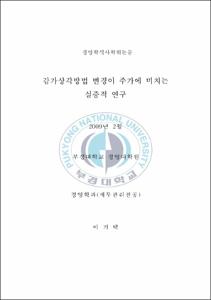감가상각방법 변경이 주가에 미치는 실증적 연구
- Alternative Title
- A Study on the Impact of Stock Prices by The Change of Depreciation Method
- Abstract
- 시장의 효율성을 측정하기 위해서는 새로운 정보에 대한 주가의 반응속도(speed of response)와 이용 가능한 정보가 무엇이냐에 따라 약형 효율적 시장가설, 준강형 효율적 시장가설, 강형 효율적 시장가설의 세 가지로 분류하고 있다. 따라서 본 연구는 1999년 1월1일부터 2007년 12월31일까지 9년간에 걸쳐 감가상각방법을 정률법에서 정액법으로 변경한 증권시장의 거래소와 코스닥에 상장된 기업을 중심으로 감가상각방법의 변경이라는 회계정보가 주가에 어떠한 영향이 있는지 실증분석 하였다.
그 검증결과 정률법에서 정액법으로 감가상각방법을 변경한 기업의 누적평균수익률은 공지 전 -54주부터 -22주까지는 등락폭이 심하게 나타나다가 -21주부터 -18주까지 더욱더 하락하였고, -17주부터 -7주까지 서서히 상승하였으며, 공시 전 -6주부터 공시 0주까지 주가가 급격히 하락하여 가설검증에 있어 유의하게 나타났다. 공시 후 1주부터 +2주까지 서서히 오르다 +3주에 다시 하락한 후, +4주부터 +23주까지 증가와 하락을 반복하다가 24주부터 30주까지 다시 하락하여 +31주부터 서서히 상승하기 시작하여 +40주까지 누적평균비정상수익률이 정(+)의 값을 가지게 되고 +47주부터 +55주까지 다시 서서히 하락하기 시작하였다.
이러한 결과는 평균잔차에 대한 t검증결과에 의하여 통계적으로 뒷받침되고 있는데, 유의수준 0.10에서는 -46주, -30주, -29주, -2주, -1주, +5주, +9주, +21주, +31주, +45주, +51주가 유의적인 차이를 보이고 있으며, 유의수준 0.05에서는 -44주, -37주, -36주, -28주, -18주, -12주, +3주, +16주, +19주, +33주, +35주, +36주, +37주에서 유의적인 차이를 보이고 있고, 유의수준 0.01에서는 -53주, -52주, -51주, -49주, -47주, -43주, -42주, -40주, -27주, -24주, -23주, -22주, -21주, -20, -16, -11주, -10주, -9주, -8주, -7주, -6주, -5주, -4주, -3주, 0주, +20주, +24주, +25주, +30주, +34주, +39주, +40주, +54주, +55주에서 유의적 차이를 보이는 것으로 분석되었다
따라서 본 연구의 검증결과를 요약하면 다음과 같다.
기업들은 감가상각방법을 정률법에서 정액법으로 변경시키는 이유는 기업의 유지 목적과 결부되고 가장 중요하다고 생각되는 것은 감가상각방법의 변경으로 인하여 정(+)의 효과를 누리고자 하는데 있다. 그러나 연구가설 “감가상각방법 변경은 공시일 이전에는 주가에 부(-)의 영향을 미칠 것이다”라는 연구가설을 검증한 “감가상각방법 변경은 공시일전에는 주가에 정(+)의 영향을 미칠 것이다”라는 귀무가설을 기각하였다. 따라서 감가상각방법 변경정보가 충분히 증권시장에 반영되지 못하거나, 투자자들은 감가상각방법 변경이라는 정보를 중요한 정보라고 간주하지 않아 주가에 영향이 없는 것으로 나타났으며, 단지 사회적 이슈나 경제정책, 산업관련정보로 인하여 시대상황을 반영한 정보만이 주가 하락에 영향이 있다고 볼 수 있다. 그러므로 감가상각방법 변경은 공시일전에는 주가에 부(-)의 영향을 미친다.
이상과 같은 감가상각방법의 변경이 주가에 미치는 영향을 실증분석 하였으나 주가에 영향을 줄 수 있는 회계정보를 감가상각변경이라는 것으로 단정지어 복합적인 회계변경 요인을 간과하였다는 것은 본 연구의 한계라 할 수 있다. 따라서 앞으로 복합적인 회계변경요인을 설정하여 좀 더 현실 반영적인 연구가 이루어져야 할 것이다.
With a view to create certain positive influences on corporate management by changing business accounting methods, most of Korean companies relied on change of accounting methods during 1980's to 1990's. In 2008, some Korean companies have changed accounting, particularly depreciation method from fixed rate method to straight line method. In the context of such change, this study intends to make empirical analysis on possible correlations between accounting information and stock price in order to determine potential effects of business accounting information on the decision-making process of information users, as well as potential effects of such accounting change on company business.
Thus, this study sought to judge if the public notification of accounting change contains useful information for investors to make decisions and identify problems concerned with accounting change, particularly the change of depreciation method. To meet the above goals, this study focused on listed companies (listed in the Korea Stock Exchange (KSE) and KOSDAQ) which changed their depreciation method from fixed rate method to straight line method for 9 years (dating from Jan. 1, 1999 to Dec. 31, 2007), so that it could make empirical analysis on potential impact of accounting information like changing depreciation method upon stock price.
As a result, this study could demonstrate a hypothesis that “changing depreciation method would have negative impact on stock price not later than the date of notification, and thereby rejected a null hypothesis that “changing depreciation method would have positive impact on stock price not later than the date of notification.”
Here, it is found that changing depreciation method had no significant impact on stock price, mainly because such accounting information like changing depreciation method was not fully reflected on stock market or investors didn't consider it valuable information at all. However, it is found that only the proper information, which reflects contemporary conditions due to social issues, economic policies or related industrial information, has influences on devaluation of stock price. Hence, it is concluded that changing depreciation method has negative effects on stock price before the date of notification.
- Issued Date
- 2009
- Awarded Date
- 2009. 2
- Type
- Dissertation
- Keyword
- 감가상각방법
- Publisher
- 부경대학교 경영대학원
- Alternative Author(s)
- Lee, Ki-Taek
- Affiliation
- 부경대학교 경영대학원
- Department
- 경영대학원 경영학과세무관리전공
- Advisor
- 김진황
- Table Of Contents
- Ⅰ. 서론 = 1
제1절. 연구의 목적 = 1
제2절. 연구의 방법 및 범위 = 3
Ⅱ. 감가상각방법 변경의 정당성과 효율적 시장가설 = 4
제1절. 감가상각방법 변경의 역사적 배경과 정당성 = 4
가. 감가상각방법 변경의 역사적 배경 = 4
나. 감가상각방법 변경의 정당성 = 6
제2절. 효율적 시장가설 = 9
가. 의의 및 전제조건 = 9
나. 모델 = 12
다. 시장형태 및 회계정보 = 17
제3절. 선행연구 검토 = 21
가. 국외 선행연구 = 22
나. 국내 선행연구 = 25
Ⅲ. 감가상각방법 변경이 주가에 미치는 영향 분석 = 35
제1절. 모형의 선택과 분석기법 = 36
가. 모형의 선택 = 36
나. 분석기법 = 37
제2절. 가설의 설정 및 자료수집 = 39
가. 가설의 설정 = 39
나. 표본기업의 선정 = 40
제3절. 가설검증 및 해석 = 45
가. 비정상수익률 = 45
나. 가설검증 및 해석 = 52
Ⅳ. 결론 = 54
참고문헌 = 56
Abstract = 60
- Degree
- Master
- Files in This Item:
-
-
Download
 감가상각방법 변경이 주가에 미치는 실증적 연구.pdf
기타 데이터 / 707.59 kB / Adobe PDF
감가상각방법 변경이 주가에 미치는 실증적 연구.pdf
기타 데이터 / 707.59 kB / Adobe PDF
-
Items in Repository are protected by copyright, with all rights reserved, unless otherwise indicated.